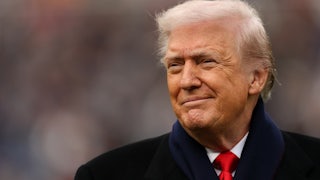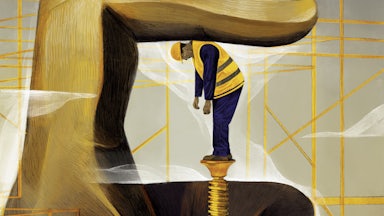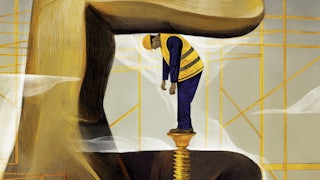On a chilly February evening at the John F. Kennedy Center for the Performing Arts in Washington, D.C., Victoria Canal, a 26-year-old singer-songwriter, was more nervous than usual before her performance. President Donald Trump had recently purged a chunk of the cultural hub’s traditionally bipartisan board—you can guess which types he targeted—and installed himself and several MAGA compatriots in their places; they, in turn, elected him as chair. Canal had debated whether to perform but ultimately decided to go ahead with the show.
Two days before she was scheduled to play, she announced she would be donating her fee to a trans equality group in an Instagram post that dared the new guys to cancel her performance. When they didn’t, she began to consider an even bolder act of protest.
“Literally, up until the moment I [walked] out onstage, I was on the phone with my lawyer,” Canal said. “Everybody was kind of advising against it.” Undeterred, after she finished her free set, she walked away from the grand piano, grabbed a T-shirt with plain block lettering—ANTI TRUMP AF.—pulled it over her dress, and took a bow. Members of the audience, aside from a few scattered booers, gave her a standing ovation.
The response online was less enthusiastic. As video of her performance spread on social media, Canal’s Instagram and other platforms were bombarded by Trump supporters and hundreds of comments a minute, attacking everything from her disability and her weight to her gender expression and her sexuality, she said. (Canal is queer, Latina, and was born without a right forearm.) “It became clearer and clearer,” she told me with a sigh, “that that audience”—the one at the Kennedy Center that stood and applauded her—“doesn’t represent America.”
For more than half a century, the Kennedy Center has made a priority of representing the rich diversity of American culture and has regularly celebrated artists of color and LGBTQ+ performers. That mission was thrown into doubt the moment Trump and his cronies took over its board. Now, the arts center would serve as a weapon in the president’s war against cultural elites.
Transforming—and MAGA-ifying—the arts have emerged among the president’s more surprising second-term priorities during his first 100 days: Even as the Trump administration has moved quickly to decimate federal agencies and defund top universities and museums, it has not targeted the Kennedy Center and the National Endowment for the Arts with the same gusto, though the Kennedy Center has seen a handful of layoffs. What has emerged instead are at times bewildering gestures toward a more insidious goal: not just chilling art deemed “liberal” and fostering right-wing arts institutions, but establishing a Trump-aligned power base through which to rival the diversity of American culture.
Trump has depicted the Kennedy Center as a crumbling building that he will return to its former glory. Never mind that he has offered few ideas for doing so and has spoken about his plans with his trademark blend of grandiloquence and vagueness. “We’ll make a lot of changes, including the seats, the decor, pretty much everything,” he promised a group of reporters in March. He justified his takeover via social media by claiming that he would put an end to drag shows and “ANTI-AMERICAN PROPAGANDA.” (The Kennedy Center hosted thousands of events last year; among them a drag story hour for queer and trans youth and a Mamma Mia! disco-themed drag brunch.) Art, in other words, is not a politically unifying force; it’s just another chance to score shots against wokeism and force liberals to get in line.
The National Endowment for the Arts, which awards tens of millions in grant money each year, could be an even more consequential front in the administration’s larger fight for cultural supremacy, if the administration doesn’t try to kill it, which had been proposed during Trump’s first term. (“Art can survive and thrive without public funding,” urged a recent briefing paper from the libertarian Cato Institute, citing such examples as Gone With the Wind, Harry Potter, and Shakespeare.)
In compliance with executive orders issued by Trump shortly after he was sworn into office, the NEA began asking grant applicants in February to certify that, if selected, they won’t promote “gender ideology,” as such projects are ineligible, or operate “illegal DEI” programs. “Do the historical posters of Rosie the Riveter promote DEI? Does the art of Romare Bearden promote DEI?” questioned Paulette Granberry Russell, president and CEO of the National Association of Diversity Officers in Higher Education, which sued the administration in February over the anti-DEI order. The NEA had dropped the certification requirements amid ongoing litigation, but the changes have already discouraged some LGBTQ+ artists and allies from applying for grants.
There’s little ambiguity over the kind of art the administration doesn’t like. But what kind of art does it support? In early February, the NEA indicated that projects celebrating the anniversary of the Declaration of Independence would get funding priority, a promise that disappeared from the agency’s website shortly after it prompted confusion and mockery. (The theme had previously been “encouraged” under President Joe Biden, which is the language now.)
At the Kennedy Center, meanwhile, Trump and his allies have espoused a cultural vision that is as inscrutable as it is crowd-pleasing: Christmas, country music, Luciano Pavarotti, Cats. A mix of artists who support the president and performances he personally likes is certainly very Trumpian, but is this really what the president meant when he promised the center was “going to have some really good shows”?
The NEA and the Kennedy Center both sprang from a well of midcentury optimism. The NEA was created in 1965 to meet the demands of Americans who had more education and time to take an interest in the arts as the nation’s quality of life dramatically improved. The Kennedy Center’s impetus came from Dwight Eisenhower, who viewed the arts as a form of soft power during the Cold War, which could combat the perception “that too many foreign peoples saw us as materialistic and militaristic,” in the words of diplomat Ralph Becker.
Unlike the Kennedy Center, whose bipartisanship Washington chummily respected, the NEA has long been a target for conservatives, who have decried it as a waste of taxpayer money and a hotbed of immorality. But over the decades, the agency has withstood numerous attempts to defund it and scandals over the occasionally controversial art (see: Piss Christ) and consistently provided vital support to artists across the country.
Many of those artists are alarmed over the latest attempt to police the agency. Luke Stettner, an artist in Columbus, Ohio, spent some 50 hours working on an NEA application to fund a yearlong exhibition centered around queer collaborative art practices, featuring a local artist who identifies as a lesbian. “Queer was maybe mentioned six times” in their application, he said. Convinced that it was doomed under the new administration, he made the “difficult decision” to pull it even before the new guidelines were put in place.
An NEA grant program for underserved communities, many of whose recipients are in red states, has been scrapped for the 2026 fiscal year. In Laramie, Wyoming, Relative Theatrics used NEA funding to get a playwriting program for public school students off the ground. To do that now—and pay artists across the state to perform the students’ work—the organization has to compete for a much more competitive NEA grant. Relative Theatrics has been able to turn to its community for help, said artistic director Sean Coyle. But it’s a predicament that highlights a reality often overlooked when NEA critics assume that private donors will step up to replace it: It’s hard to support artists that never had a chance to make art in the first place.
The same day that Trump’s takeover of the Kennedy Center was announced, Chris Nee, co-creator of the children’s musical Finn, learned the center was canceling its sponsorship of a planned two-year national tour for financial reasons. Nee and her colleagues had good reasons to doubt that explanation—among them, they had been in talks about the planned tour as recently as late January. She suspected the termination was ideological: The play is about a shark who likes bright colors and sparkly things. “It’s for those kids out there that I think are so unbelievably under attack right now,” she said.
If the Kennedy Center’s new leaders have tried to avoid controversy when canceling performances like Finn, they’ve eagerly drawn attention to artists who have pulled out in protest. In March, Lin-Manuel Miranda yanked a long-planned production of Hamilton, citing the administration’s politicization of the Kennedy Center. Trump sniffed that he never liked the hit musical anyway, but the rift revealed yet another problem: It’s hard to attract audiences if you’ve alienated many of the country’s most popular artists.
The Trumpified Kennedy Center also risks alienating much of its audience in progressive Washington, D.C. When Vice President JD Vance and his wife, Usha, attended the symphony in March, they were resoundingly booed, prompting Richard Grenell, the center’s interim president, to send a staff email, as reported by The Washington Post, insisting that they make the Kennedy Center a “place where everyone is welcome” and that he takes “diversity and inclusion very seriously.”
Given that the administration had just gutted DEI programs, it was a jaw-droppingly ironic statement, made even more so when the Kennedy Center subsequently laid off staffers in charge of bringing diverse communities to the performing arts space. But more than calling for civility, he was taunting the administration’s critics, a subtext that became literal when he goaded a concerned musician over email. “Every single person who cancelled a show did so because they couldn’t be in the presence of republicans,” he wrote. The message was unmistakable: You wanted diversity and inclusion in the arts—now you’re going to get it.
Cultural DEI is not a bad way of understanding Trump’s weaponization of federal arts funding and his takeover of the Kennedy Center. There have been clumsy signals—like Trump wanting to use some NEA money to build his own sculpture garden—that the administration hopes to use its newfound power to cultivate Trump-approved art. For now, audiences are booing, artists are canceling, and the Kennedy Center hasn’t gotten any Trumpier.
Lee Greenwood, a country music singer who was reappointed to the Kennedy Center board in February, and who was previously chosen as a trustee during Trump’s first term, isn’t worried about the early turbulence. Trump wants to bring the Kennedy Center “to its former beauty,” said the singer, whose hit “God Bless the USA” has long been a staple of Trump’s rallies. “I totally agree with it.” When I asked what sort of shows the new Kennedy leadership might feel are underrepresented, Greenwood said that he didn’t want to get political. Programming decisions, he expected, would not be made by Trump; they are based on entertainment and business value. “If they have a bunch of dancers that are gay or not gay,” that’s “not going to be an issue,” he said.
When discussing his plans for the Kennedy Center, Trump frequently stumbles into a version of his political message by invoking a bygone era of mass entertainment that wasn’t tainted by politics. American Culture can be made Great Again—as long as it is forbidden from engaging with the world around it. On the one hand, this is a very old vision: Demagogues have attempted to use bread and circuses to satiate the masses for millennia. But it’s also apparent that, beyond the Kennedy Center and the NEA, there is a clear desire to showcase art with a distinctly Trumpian spin—even if no one seems entirely sure of what that would look like in practice.
It’s fitting that Trump’s primary artistic interest seems to be portraits of himself. In March, he criticized a commissioned oil painting in the Colorado state Capitol as “purposefully distorted,” but was reportedly “touched” by a more flattering portrait gifted to him by Russian President Vladimir Putin. He and his allies have recently shared images of dubious artistic origin depicting himself in a number of flattering guises: as a star NFL player, as Rambo, even as a king.
Canal, the singer-songwriter who protested at the Kennedy Center, hypothesized that only AI art can give the president what he wants. Because “no artist in their right mind,” she said, “is going to be making art about Trump.”






